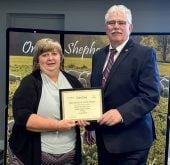Glacier FarmMedia – An opportunity exists to build a larger, higher quality wool production industry in Canada, according to The Campaign For Wool Canada (TCFW), and the organization has developed a five-year strategic plan to do that.
“There are definitely challenges but there are huge opportunities in Canadian wool,” said Matthew Rowe, TCFW Canada chief executive officer. “With some investment and encouragement, we think we can build a sustainable wool industry here.”
Why it matters: Wool is seen as a sustainable choice for consumers and has many uses beyond clothing. Building a market in Canada would also increase profits for sheep producers.
Read Also

Canada seventh-most influential country on agri-food
Report from Dalhousie University and MNP shows Canada ranks seventh among G20 countries on agri-food influence.
Rowe said Canada has in the past had a significant domestic level of wool production with a corresponding infrastructure, but the rise of synthetic materials pushed much of the wool industry out of fibre markets.
While that continues to be the case, there is a growing demand for sustainability from consumers.
It’s a shift that TCFW’s patron, Prince Charles, recognized, and it spurred the royal to found the organization more than a decade ago with its Canadian branch established in 2014.
“I think there is a renaissance in customers rediscovering quality, in really caring for where their clothing is made, how it’s made, what it’s made with,” said Rowe.
He said leadership is needed to tout the qualities, sustainability and benefits of wool for the domestic clothing market and for its use in everything from packaging to home insulation.
“Collectively, there is an industry here,” he said, highlighting that it’s spread sporadically across the country. “There are companies that are still manufacturing here, we use wool in a variety of products but what we have to do as an industry is make it easier for them to use Canadian wool.”
Rowe said TCFW Canada is in talks with the different levels of government regarding how best to develop research and marketing.
For wool mill manager Maddy Purves-Smith, who runs Custom Woolen Mills in Carstairs, Alta., the sustainability of the fibre shouldn’t be underestimated.
Custom Woolen Mills uses only Canadian wool at its production facility, which might seem large in the Canadian context but is small by global standards.
“There aren’t that many processors left in North America. Most of the wool is being exported,” she said. “Then you are dealing with a global commodities market where Canada is not a very big player. So that impacts the price that producers can get for their wool.”
The sheep industry also depends on the lamb meat side of the business, with wool seen as byproduct. Wool can be subject to supply issues based on how the main revenue source ebbs and flows.
But there is potential, added Purves-Smith. Wool’s attributes are a good fit with consumer tastes, which are moving toward sustainable products.
“You don’t have any issues with micro-plastics in the ocean and it’s one of the very few natural fibres that is ready to process directly off the farm,” she said. “In terms of a sustainable textile, it’s got a lot of room — it’s a market that can expand in the future. There is a lot of potential.”
That potential coupled with branding as a quality product from Canada is the message that TCFW wants to promote, said Rowe.
“There is a premium to be had in the market there and we’re not talking about massive quantities of wool compared to the global industry,” said Rowe. “It’s about finding the right mix and diverting some of that 90 per cent of our wool that goes to China and is sold at the lowest commodity price.”
Producers could receive higher prices if the organization can better develop domestic markets, he added.
TCFW Canada’s five-year strategic plan cites three primary goals to be completed by 2026: rebrand Canadian wool, advocate for the wool value chain and provide a global voice for products from Canada.
– This article was originally published at The Western Producer.














